
The European market potential for fishing tourism
Fishing tourism is a large tourism niche that makes an important contribution to local economies possessing natural resources and a well-established fishing infrastructure. There are 25 million recreational anglers in Europe, which makes it an important source market for fishing tourism. Germany, Italy and the UK are amongst the leading markets. Sustainability is a major trend in fishing tourism, as anglers understand the need to protect fish species and respect their habitats.
Contents of this page
1. Product description
Fishing tourism comprises travel away from home for the primary purpose of fishing, either in freshwater or saltwater. It involves individuals or groups travelling to destinations for the purpose of fishing for leisure or sport. These destinations include freshwater (lakes, ponds, reservoirs, rivers and streams) and saltwater environments (oceans and seas) that are home to plenty of fish species. Fishing is often referred to as angling.
Tourism entrepreneurs can further specialise, depending on the type of fishing that is offered. Angling covers various fishing techniques, and there is a crossover between definitions. These are discussed in the table below.
Table 1: Fishing types, description and techniques
| Specialist Niches/Fishing Type | Description and techniques |
| Freshwater fishing |
|
| Saltwater fishing |
|
| Game fishing |
|
| Specialised fishing |
|
Source: Acorn Tourism Consulting, 2024
Fishing tourism often includes other features beyond fishing activities: accommodations in fishing lodges or resorts, guided fishing expeditions, boat rentals, and eco-tours focusing on the local aquatic environment and wildlife.
Fishing tourism contributes significantly to local economies, especially in regions with abundant natural resources and well-developed fishing infrastructure. In addition, fishing tourism can promote conservation efforts by fostering an appreciation for natural habitats and encouraging sustainable fishing practices.
Examples of fishing tourism experiences
Fishing trips are quite varied, with worldwide destinations, and choice depends on the angler and their preferences and skill level. Catch-and-release is the predominant choice on fishing holidays these days, where the fish is caught and returned the water unharmed (after being measured and weighed). It is widely regarded as a more sustainable form of fishing, since population stocks can be preserved and the ecosystem maintained.
Table 2: Examples of fishing holidays and trips on the market, 2024
| Trip details | Description |
Type: Freshwater fishing/fly fishing | A fishing trip to fish for sea trout on the Irigoyen and Malenguena rivers in Argentina. Guests stay at World’s End Lodge, a famous sea trout fishing lodge in Tierra del Fuego. The river is famous for large sea trout and is a challenging experience for anglers interested in game fishing. |
Hosted big game fishing in Madagascar Type: Saltwater fishing/game fishing | Newly introduced in 2024, this is a hosted (or guided) fishing trip specialising in popper and jig fishing in the rich waters around Madagascar. Accommodations are all-inclusive on a liveaboard catamaran.
|
A stay at Gillham’s Fishing Resort, Thailand
Type: Freshwater fishing/coarse fishing | This fishing resort caters to anglers of all abilities. The lake stocks 52 different species, including six weighing over 45kg, like arapaima, Mekong catfish and freshwater stingray. The resort is staffed by English-speaking guides. Guests stay in luxury bungalows located around the lake. |
Off-the-grid arapaima jungle adventure, Guyana Type: Freshwater fishing/game fishing | A fishing trip that combines adventure and technical fishing for some of the most exotic and interesting fish species. Arapaima is the largest scaled freshwater fish in the world: its weight can exceed 315kg and its length surpass 300cm. Accommodations are at Rewa Eco Lodge, located near the confluence of the Rewa and Rupununi rivers. |
Type: Saltwater fishing/game fishing | A game fishing trip (also known as bluewater fishing) in the Indian Ocean off the Kenyan coast for species including shark, marlin, tuna, trevally and barracuda. Accommodations are at the 5-star Hemingways Hotel in Malindi or the 3.5-star Turtle Bay Beach Club. |
Type: Saltwater fishing/fishing for specific species | Bonefishing is usually done in shallow saltwater areas where bonefish live. Cuba has extensive areas in Cayo Paredón and Canarredos. Cayo Paredón is a new resort that caters to all types of tourists, including anglers.
|
Deep sea fishing in Cabo San Lucas, Mexico Type: Saltwater fishing/game fishing | A 5-hour private deep-sea fishing trip off the coast of Cabo San Lucas in Mexico, one of the best places to catch marlin. The trip includes use of all fishing equipment; it can be upgraded to a full-day (8-hour) trip. |
Giant Monster Fishing Tour, Vietnam
Type: Freshwater fishing/game fishing | A 2-day trip from Ho Chi Minh City to the Ba Ria province for a catch-and-release freshwater fishing experience. Fish for some of the largest fish species, like Mekong giant catfish, Siamese carp, alligator gar and Amazon redtail catfish. Also includes a night fishing experience. |
Source: Acorn Tourism Consulting, 2024
Fishing tourism in marine environments is part of the blue economy. The blue economy is a term to describe the economic activities associated with oceans and seas. Maritime and coastal tourism are amongst the most important components of the blue economy. A sustainable blue economy supports local communities in earning a living from oceans and coastal regions while respecting the long-term ability to regenerate regions through sustainable actions. It is therefore essential that fishing tourism be practised sustainably.
Read more about the blue economy in the EU Blue Economy Report 2022.
Figure 1: The benefits of the blue economy
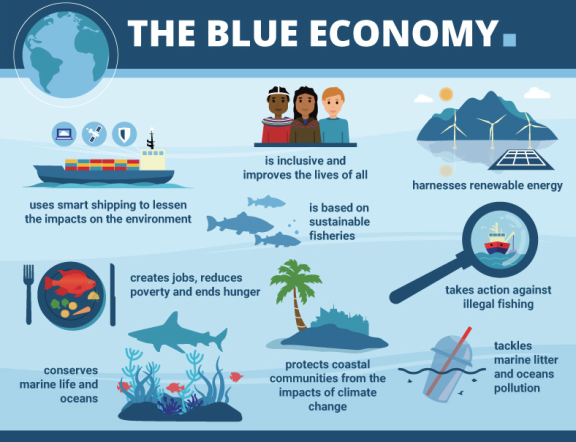
Source: Blue Tourism Opportunities, 2022
End-market segmentation and consumer behaviour
Fishing tourists/people who fish are commonly referred to as anglers. Anglers can be segmented into two broad groups:
- Anglers travelling for the primary purpose of fishing: in this case the destination and species sought will be the key factors when planning a trip.
- Anglers on a broader tourism trip where fishing is not the main purpose of a trip: these tourists will spend some of their time fishing, and will seek good fishing opportunities and other interesting experiences for non-fishing family members.
A further segmentation involves how fishing is practised:
- Recreational fishing tourism from a charter or hired boat in both freshwater and marine environments.
- Non-boat marine or freshwater recreational tourism fishing, typically from beaches, cliffs or piers (marine), and rivers, lakes and dedicated fishing lakes/ponds (freshwater).
Figure 2: Measuring and weighing fish before release is part of the fishing experience
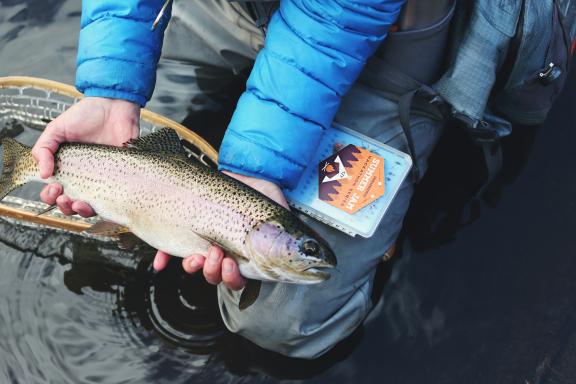
Source: Sticker Mule at Unsplash, 2017
Anglers that take part in fishing tourism are all quite individual and have different preferences based on fish species, fishing techniques, people they fish with, destinations and so on. The chart below shows the wide range of angler types.
Table 3: Angler Types
| Angler Types | Primary Motivation (in priority order) | Size of Market | ||
| Adventurous Angler | This thrill and challenge of fishing | I want an outdoor activity that connects with me | I am fascinated by fish | 18% |
| Zen Angler | Get away and relax | n/a | n/a | 18% |
| Friendly Fisher | Connecting with family or friends | Spending time outdoors | Get away and relax | 16% |
| Consumptive Angler | Catching fish for food | Fishing is a tradition that was passed down to me | I want an outdoor activity that connects with me | 12% |
| Social Dabbler | Connecting with family or friends | n/a | n/a | 12% |
Occasional Angler | To meet a challenge | n/a | n/a | 13% |
| Traditionalist | Passing on my love of fishing to others | To be part of conservation efforts | Fishing is a tradition that was passed down to me | 11% |
Source: Southwick Associates, 2020
Each type is further analysed:
- Adventurous Anglers: are motivated by the thrill and challenge of fishing and by being outdoors. They have a personal connection with fishing and are fascinated by fish. One of the largest groups of anglers. They fish regularly and have a high skill level. They are on the lookout for new places to fish. Most likely to travel somewhere new or different to fish, and to catch big fish.
- Zen Anglers: use fishing as a getaway strategy to relax and spend time outdoors. They are more solitary than other groups, however they also like friends and family to accompany them on a trip. With Adventurous Anglers, they are the largest group.
- Friendly Fishers: amongst the most affluent of the angler groups, and like fishing as a way to enjoy time with friends and family, spend time outdoors and relax. They are often beginners and do not spend much money on fishing equipment. More likely to travel with a group of likeminded people. They look for places to fish that are free of crowds and have scenic beauty.
- Consumptive Anglers: like to catch fish predominantly to eat. They fish more than all the other types. They prefer to fish with other like-minded people and in places where there is an abundance of fish.
- Social Dabblers: prioritise having fun and being outdoors with friends. They like to participate in many outdoor activities, including fishing. This group of mostly beginners has more women (53.6%) than men (46.4%).
- Occasional Anglers: have a lower motivation to fish for social reasons, but are particularly inspired to fish with a goal in mind, like catching a trophy fish or targeted species. The challenge is important to them. They are happy to fish occasionally, although they do like to improve their skills.
- Traditionalists: start fishing at an early age. They are older and more affluent, and tend to be more advanced than other angler groups. Fishing is their passion and they want to pass on their love and knowledge to others. Conservation is very important to them. They are likely to travel to new or different places to fish, and to catch big fish.
The most relevant groups to target with fishing tourism are Adventurous Anglers, Zen Anglers, Friendly Fishers, Social Dabblers and Traditionalists, each for different reasons. Download the research to find out more about Angler Personas and Understanding Anglers’ Motivations.
Angler Demographics
Anglers have diverse demographics, although broadly speaking they are mostly male (53.8%), with an average age of 42. There is some evidence that more women are showing interest and taking part in recreational fishing. Age, income levels and professions vary across the group, although they are mostly well-educated. However, fishing tourism can be an expensive pursuit, especially when boats and specialist equipment are involved. Therefore, anglers taking part in fishing tourism are likely more wealthy tourists.
Anglers tend to be passionate and dedicated to their sport. On average, an angler spends around 17.9 days per year fishing. According to CBI research, when on a fishing tourism trip in 2022 anglers stayed an average of 9.9 nights and spent 36% more than general tourists.
Angling is known to be a good way to deal with stress and stay healthy. A survey in the UK conducted in 2018 found that 72% of respondents said fishing kept them healthy and 70% helped them de-stress.
Targeting the angling population offers adventure tour operators additional opportunities. Research shows angling to be a good ‘gateway’ activity – 75% of anglers also take part in other outdoor activities such as walking, hiking, camping and golf.
Accessible tourism on the European market
Accessible tourism is the ongoing endeavour to ensure tourist destinations, products and services are accessible to all people, regardless of physical limitations, disabilities or age. It encompasses publicly and privately owned tourist locations. The improvements not only benefit those with permanent physical disabilities, but also parents with small children, elderly travellers, people with temporary injuries such as a broken leg, as well as their travel companions. Disabled tourists may travel individually, in groups, with their family or with carers.
Accessibility and fishing tourism
The UK has a large population of anglers with varied disabilities; 54,000 disabled anglers hold a fishing licence. More than 165,000 people aged 65+ also purchase annual fishing licences. This age group is increasingly developing health issues that may limit their mobility. According to the UK-based Angling Trust, around one in five of all those who would like to go fishing have a disability or health issue that affects their physical activity level.
It can be assumed that figures are similar throughout Europe and that there are large numbers of people with a variety of disabilities who would like to participate in fishing.
Making your business accessible to anglers with disabilities is not only the right thing to do but can help your business financially. Depending upon what type of business you manage, some issues to consider when planning to make your business more accessible include:
- Ensuring walkways and routes are suitable for reduced mobility and/or wheelchair use, and that there is proper signage.
- Making information accessible, including marketing materials, maps and website.
- Putting in place proper facilities for people with disabilities, like bathrooms and access ramps.
- Providing suitable access to boats, such as wheely boats, which allows users to wheel themselves on board.
Download this detailed guide, Access to Angling – best practice guidance, for tips to make your business accessible. For best-practice examples of fishing trips for disabled people, check out this range of accessible fishing holidays offered by UK-based tour operator DisabledHolidays.com.
Tip:
- Read the CBI studies The European market potential for accessible tourism and Entering the European market for accessible tourism products for practical and useful advice on making your tours accessible.
2. What makes Europe an interesting market for fishing tourism?
Europe is an interesting market for fishing tourism, given the many anglers who like to fish at home and abroad.
The global fishing tourism market was estimated at US$72.5 billion in 2023 and is projected to reach US$211.1 billion by 2033. This represents a CAGR (compound annual growth rate) of 11.3% for the 10-year period. The US is the largest market for fishing tourism, estimated at 18.3%. Growth is attributed partly to coastal fishing towns and destinations diversifying activities towards tourism, as fishing incomes have declined. In addition, demand has risen for specialised trips for a single activity, like fishing.
It is estimated there are 25 million European recreational anglers who fish with a rod and line. Up to 7 million European anglers belong to an angling club or organisation. Recreational sea anglers spend €10.5 billion every year on fishing activities and equipment. Recreational fishing in Europe is a growing market, and 13.6% of tour operators are active in the fishing tourism niche.
Fishing is a major part of the European region’s culture and economy. It is amongst the most popular outdoor recreational activities, particularly in coastal areas. The wide range of fishing locations (lakes, rivers, ponds, coastal regions) throughout Europe has made recreational fishing more accessible to a wider audience and is driving growth in the sector.
The rising interest in sustainable tourism and ecotourism in the target market has also created opportunities for the fishing tourism segment. Fishing is an activity that takes place in natural, often pristine surroundings, which appeals to outdoor enthusiasts who want to be close to nature. That catch-and-release is now the predominant form of fishing tourism is another indicator of the desire for sustainable actions in the segment.
Figure 3: Deep-sea fishing for game fish like tuna and marlin is a popular fishing tourism activity
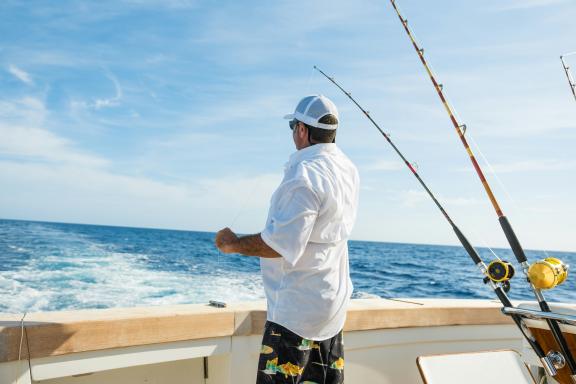
Source: Antonio Scant at Unsplash, 2019
Tip:
- Find out more about European outbound markets: the CBI studies on the demand for outbound tourism and trends that offer opportunities or pose threats are good knowledge-building sources.
3. Which European countries offer the most opportunities for fishing tourism?
The European countries that offer the most opportunities for fishing tourism in developing destinations are Germany, Italy, the UK, Sweden, the Netherlands and France. This is based on the estimated number of recreational anglers in each country and their willingness to travel to long-haul destinations.
European anglers from source markets travel to a wide range of destinations in developing countries to fish. Popular saltwater (game) fishing destinations include the seas around Mexico, Kenya, Costa Rica, the Caribbean and Thailand. Developing destinations are also particularly popular for freshwater fishing in large rivers, like the Amazon (Brazil), Zambezi (Zambia/Zimbabwe), Essequibo (Guyana), Kerala Backwaters (India), Mekong (Thailand/Laos/Cambodia/Vietnam) and Rio San Juan (Nicaragua).
Germany
Germany is the leading European country for fishing tourism. In 2021, 6.64 million people over the age of 14 went fishing at least once. This amounts to around 9.4% of the total population. The recreational fishing sector generates €6.4 billion annually and supports 52,000 jobs. In 2022 the country had a 4.3% share of the global fishing tourism market, trailing the United States (19.3%), Australia (6.3%) and Japan (5.8%).
Recreational fishing is represented by the German Fishing Association (DAFV), with around 500,000 members and 9,000 affiliated clubs. It is one of the largest recognised conservation and environmental associations in Germany.
Freshwater angling is the most popular type of fishing in Germany. Around 200,000 Germans participate in sea angling every year, adding up to 1.8 million days. They are high spenders on their hobby, with average expenditures of €900 on items including fishing boats, fishing tackle, travel and accommodations.
Research conducted in the German state of Bavaria found that 31% of anglers took organised fishing trips every year. Angling tourism in the region accounted for 40% of all angling expenditures, split between overseas destinations (55%) and domestic destinations (45%).
Some German fishing forums, all with sections relating to travel:
- Anglerboard, one of the largest and most active fishing forums
- Fisch Hitparade
- Blinker Forum, which is part of Blinker magazine
Italy
Italy has around 2.5 million recreational anglers, 100,000 of whom take part in fishing competitions. The value of the sector is estimated to exceed €3 billion. Italian anglers are particularly interested in sport fishing and competitions, which are well established in the sector.
There are several fishing associations in Italy. The Italian Federation for Sport Fishing and Underwater Activities (FIPSAS) is the largest. Arci Pesca Fisa promotes fishing and environmental conservation, and organises fishing events, competitions and educational programmes. It has a fishing tourism section on its website. Enalpesca promotes fishing sports and safeguarding aquatic environments.
PescaForum and PescareOnline are forums for Italian anglers to share information, pick up tips and more.
United Kingdom (UK)
Fishing is popular in the UK and is one of the largest participation sports. In 2019, about 2 million people took part in recreational fishing. The recreational fishing sector contributes over £4 billion a year to the British economy. There are more than 2,500 member clubs and fisheries in the UK, and over 500,000 individual members.
Freshwater angling is the most popular form of fishing in the UK, accounting for 70% of angling days. Coarse fishing for the carp species is the most popular, accounting for 7 million days fishing time out of 19 million total days, and 1.6 million days were spent fishing for salmon and trout. Around 800,000 UK adults went sea angling at least once a year between 2016 and 2017, for a total of 7 million days. Freshwater angling contributes £1.4 billion to the British economy every year and supports 27,000 jobs.
Of particular importance to coastal communities in the UK is recreational fishing, which can harness out-of-season participation to generate additional income. Recreational sea angling is estimated to contribute twice as much to the British economy than the commercial fishing sector.
British fishing forums include:
- The Anglers’ Forum, which only has a Facebook page for now
- Fishing Magic, specialised in coarse fishing
- AnglersNet, the UK’s online magazine
Sweden
Sweden has a strong tradition of fishing for leisure. Surrounded by water and more islands than anywhere else in the world, fishing is an extremely popular pastime for the Swedish: 1.2 million adults (aged 16-80) went fishing in 2022, which accounts for around 11% of the total population. This is a higher participation rate than any of the other source markets.
Swedish anglers took a total of 12.2 million fishing days in 2022. Freshwater angling accounted for 70% of fishing days compared to 30% in the sea. Half of all fishing days were taken from a private boat or tour boat. Expenditure in recreational fishing in 2022 was SEK 9.5 billion (€469.5 million), of which SEK 5.7 billion (€490.1 million) was spent on fishing equipment, travelling, fishing guides, food and accommodations.
Also in Scandinavia, Norway and Finland are likewise interesting markets to target for angling tourism, as they also have high participant rates compared to their total population.
Netherlands
The Netherlands are a good market to target for fishing tourism as, following an increase in participation after the pandemic, there are an estimated 1.7 million Dutch anglers. This is up from 1.1 million in 2017. Dutch anglers are predominantly men (53%), while women account for around 28%. Children’s participation is also on the rise, accounting for 19%.
There are hundreds of local fishing associations affiliated with Sportvisserji Nederland through seven regional federations, and membership has also grown since the pandemic. Visserslatijn is an online forum for anglers that covers a wide range of topics.
France and Spain
Though they are smaller markets, France and Spain still offer good opportunities to market fishing tourism.
In France there were 1.4 million anglers in 2022, of which 321,517 were under 18 and 109,417 were women. The number has remained stable over the past few years. The sector generates over €2 billion for the French economy, and is supported by the National Federation of Fishing in France (FNDF). French anglers are predominantly male and spend an average of €681 every year on their hobby.
In Spain, 1.2% of the population regularly participates in recreational fishing, which amounts to about 573,000 people (2018). Sea angling (maritime) is more popular amongst Spanish anglers, accounting for 900,000 participants, compared to 500,000 inland (continental) anglers.
The infographic below (in Spanish) shows that:
- Spanish anglers have an average age of 40 and are predominantly men. There is a recognised opportunity to attract more women to the sport, as they account for just 10% of participants.
- 75% of anglers fish from the shore, 20% fish from boats. A further 5% fish underwater.
- Recreational fishing makes an annual contribution of between €1,000 and €6,000 per angler to the development of rural areas.
- Fishing has positive benefits for participants’ health and is known to reduce stress.
Figure 4: Maritime and continental recreational fishing in Spain
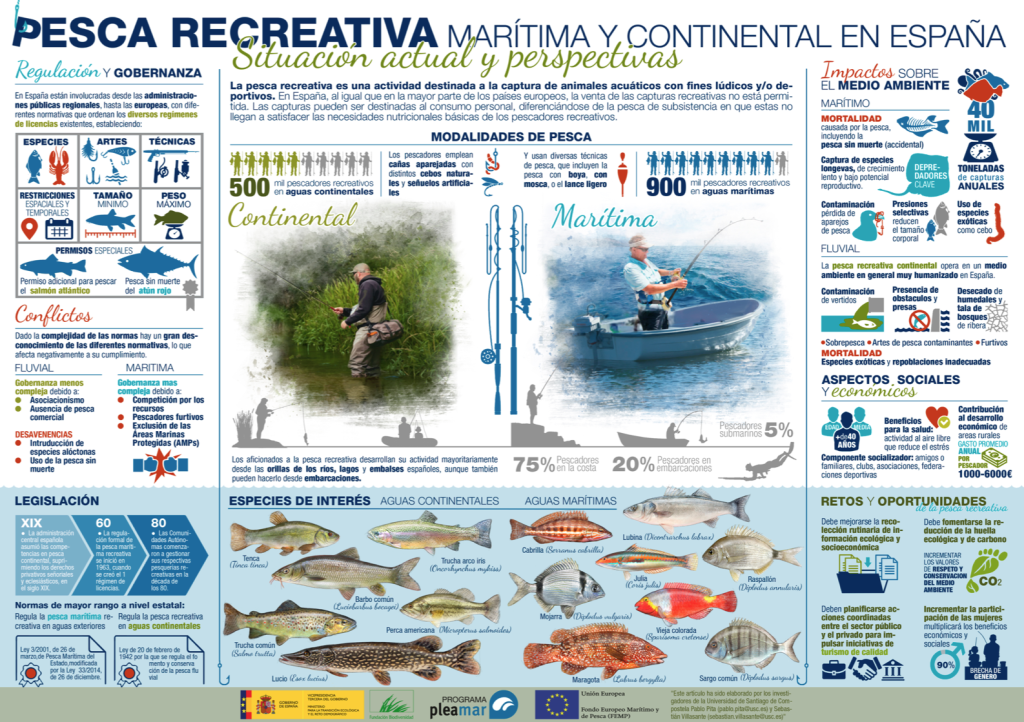
Source: Programa Pleamar, 2017
Tips:
- Explore the European sector further. It is represented by the European Anglers Alliance (EAA) and the European Fishing Tackle Trade Association (EFFTA). Most countries also have their own national and regional recreational angling associations that represent their interests.
- Note that the EAA and EFFTA are calling for a pan-European study on recreational fishing to be conducted every five years to help find out more about recreational anglers in Europe. A study would be modelled on a similar study to be conducted in the United States. Keep on checking to see if this study is planned or in the pipeline.
- To find out how to sell your fishing products to the European markets, read the CBI study Entering the European fishing tourism market.
4. Which trends offer opportunities or pose threats in the European fishing tourism market?
Sustainable fishing is the major trend in fishing tourism. Anglers are extremely sustainably-minded – they have a much more positive fishing experience if fish stocks are abundant and the fish themselves are healthy. Interest in the market is being driven by an enduring desire to be outdoors in nature to improve personal health and wellbeing. Technological developments and fishing influencers are also having driving growth in recreational fishing.
Sustainability is the key trend in fishing tourism
Fishing tourists are increasingly conscious of the environment and of the need to protect fish species and respect their habitats. Through their passion, they can see firsthand the harmful effects of pollution, commercial overfishing, habitat destructions and other threats to aquatic life. Recreational anglers have long been a strong voice for conservation – good stocks of healthy fish make for a more satisfying fishing experience.
Sustainable fishing practices are much more common these days, and fishing tourism operators are also adopting more sustainable fishing practices. Some ways that sustainability is practiced in recreational fishing:
- Carbon-conscious fishing: reducing the amount of carbon emitted in fishing trips by boat. Electric boats are quite new to the fishing tourism market and are good news for ‘stealth fishing’ to reach fish silently. In the meantime, using a stainless steel propellor reduces drag and is therefore more efficient. An electric fuel metre allows users to carefully monitor fuel consumption to maximise energy efficiency. Alternatively, surfboard fishing is completely carbon-neutral.
- Catch-and-release: now the predominant form of fishing, catch-and-release helps sustain fish stocks and create healthy fish into the future. However, it is important to learn the correct techniques associated with catch-and-release. This involves using a barbless hook or circle hook, which is less likely to catch the stomach, throat or vital organs of the fish and improves its chances of survival upon release.
- Line-and-rod fishing: concentrating on one fish at a time is the most sustainable form of fishing. It causes no harm to the ecosystem, although there is some harm to the fish. Taking steps to reduce suffering and stress to the fish are essential measures.
- Lead-free tackle: replacing traditionally used lead in fishing jigs and sinkers is important to improve the health of fish. Lead poisoning is known to contribute to muscular and neurological degeneration, poor growth and reproductive problems. Lead poisoning can also affect birds like loons and eagles, who feed on fish that have swallowed lead sinkers.
- Remove all trace: leaving nothing behind after a fishing trip is a basic sustainability practice. Fishing debris left on coastlines and water banks, like fishing lines and general rubbish, is extremely harmful to the environment and resident animals/sea life.
- Use all parts of a catch: after cooking and eating, composting the remaining parts of the fish with sawdust, peat, wood chips or leaves is a good way to reduce waste.
- Conservation and education: teaching fishing tourists about local ecosystems, marine conservation initiatives and the importance of preserving natural habitats for future generations helps reinforce key sustainability messages. It is a good idea to encourage guests to become stewards of the environment and actively participate in sustainability initiatives.
To find out more about how electric boats are starting to transform the fishing industry, read this blog about a German-Dutch startup company hiring out electric motors to local fishers in a fishing town on Lake Victoria in Kenya. It is anticipated that only electric boats will be in use on Lake Victoria by 2040.
You can also see how this tour operator, Nacarcosta in Costa Rica, commits to sustainable fishing on its fishing tours. It offers a range of sustainable fishing trips, e.g. by kayak, boat or walking to the fishing station. It also cultivates the live bait itself in aquaculture bays.
Consumer demand to spend more time in nature
Growth in the interest in recreational fishing is being driven by an overarching desire to spend more time outdoors, in nature. A trend that really took off during the COVID-19 pandemic, getting away from it all, ‘recharging batteries’ and focusing on physical and mental health, all became reasons for wanting to spend more time outdoors. Fishing in peaceful, tranquil places is a calming activity and is known to help reduce stress. Fishing in more challenging situations, like deep-sea fishing, is exhilarating and exciting.
This trend is also leading to a demand for greater personalisation and customisation of trips, and for specialised experiences. The range is large, which provides great opportunities for local tour operators. Private fishing charters, personalised guiding services and tailor-made itineraries based on fishing goals are being sought after. They can also be personalised to cater for different skills levels, which is good to attract newcomers to the sport as well as non-fishing companions.
This trend matches the need of anglers looking for fishing experiences in exotic and remote destinations to catch species they may never have caught before. These destinations are usually off the beaten track and out in spectacular nature. Game fishing in both freshwater and saltwater locations is amongst the most popular forms of fishing while on a fishing tourism trip.
Technological developments driving interest in fishing
As in many niche markets, technology is having an impact and contributing to enhance the fishing tourism experience. This includes the use of GPS navigation systems to help anglers mark fishing spots and drones scouting for fishing spots. Drones can be used in both freshwater and marine locations, and are especially useful to find fish in hard-to-reach and deeper areas.
For fishing tourists, being able to research, plan and book online are key technological developments that make things easy. Social media is contributing too, with influencers showcasing their adventures, helping to increase the interest in fishing tourism. Explore Mike Iaconelli, Ryanizfishing, Valentine Thomas and Fish with Carl.
Figure 5: Fishing influencers are helping to increase interest in fishing
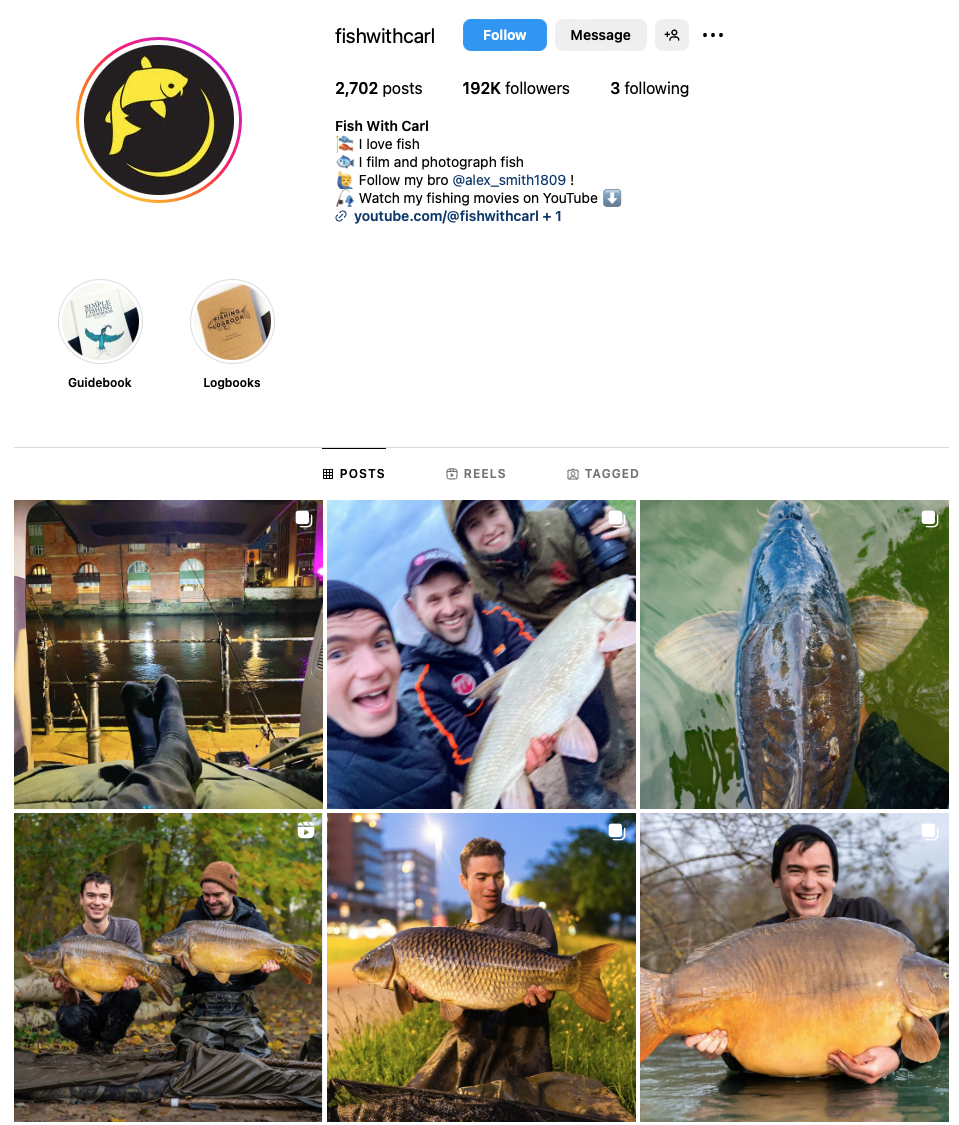
Source: Instagram; fishwithcarl, 2024
Tips:
- Commit your business to sustainable fishing practices. Only allow catch-and-release, or set strict limits on fish that can be caught for personal consumption purposes only. Make sure the equipment you use is fish-friendly. If you have a boat, consider investing in an electric motor.
- Consider your fishing trips carefully. Offer private and tailor-made trips if you can. Offer a range of experiences to appeal to different preferences of anglers.
- Find out more about trends in the tourism sector. The CBI study What trends offer opportunities or pose threats on the European outbound tourism market? is a good place to start.
- Find more tips to build your fishing tourism business in the CBI study Entering the European market for fishing tourism.
Acorn Tourism Consulting Limited carried out this study on behalf of CBI.
Please review our market information disclaimer.
Search
Enter search terms to find market research
